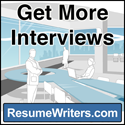Posted by Brian McCullough
 Think of your resume as your best tool in marketing yourself as the most qualified candidate for a given job. In order to achieve the goal of getting an interview, you must adjust your resume and cover letter to the specific job for which you’re applying. Tailoring your resume emphasizes the specific skills you possess that meet or exceed employers’ needs and identifies your strengths and characteristics that make you stand out as the best candidate for the job.
Think of your resume as your best tool in marketing yourself as the most qualified candidate for a given job. In order to achieve the goal of getting an interview, you must adjust your resume and cover letter to the specific job for which you’re applying. Tailoring your resume emphasizes the specific skills you possess that meet or exceed employers’ needs and identifies your strengths and characteristics that make you stand out as the best candidate for the job.
Because many companies now use digital scanning to make the first pass through applicants’ resumes, it may not matter if you have a master’s degree and the perfect experience if you don’t make a little effort to prepare your materials the right way. Consider these tips to tailor your resume and cover letters just a little:
1. Include the job title of the position you’re applying for in the “objective” section of your resume. This catches the human resource or hiring manager’s eye within the first few seconds of viewing your application.
2. Keep a spreadsheet of your accomplishments and skills, categorized by job type, field of work, or experience level. Then, when creating a resume and cover letter for each application you submit, you can refer to your spreadsheet, sorting by type of skills, level of experience, and other successes and capabilities. Continually update your spreadsheet of accomplishments and newly gained skills as you achieve them.
3. Include important keywords from the position description and place them early on in your resume and cover letter. Commonly used keywords include computer programming languages, software competencies, and specific types of skills such as data analysis or web design. Include these keywords exactly as you see them in the job description. Many companies initially search resumes and cover letters digitally and eliminate those that don’t contain desired keywords, even if the applicants have the right qualifications.
4. Focus on nouns and not verbs. Old advice used to center around action verbs and writing in the first person to highlight your experience and skills. However, with new screening processes, nouns such as the names of computer languages or software packages get the most attention from hiring managers. Double-check that you’ve spelled these names correctly, as spell-checking programs may not properly handle these words.
5. Use creativity in your layout. Effective spacing, margins, and organization allows the hiring manager to easily read and scan your resume and cover letter. Making your resume eye-catching and visually appealing while keeping it well organized and clearly readable greatly enhances your chances of being selected for an interview.
While many companies require electronic submission of resumes and cover letters, other companies opt for hard copies. Traditionally, resumes and cover letters should be printed on thicker, high-quality, bright white paper. However, if the position you are applying for is in a creative field, consider a different paper type when making your submission.
Tailoring your resume to a specific job application only requires a short amount of additional time and effort on your part. However, this investment increases your chances of getting noticed and advancing to the next step of your job search. Good luck!
Related posts:
- Don’t Include These Skills On Your Resume
- New Graduate Resume – 5 Things to Get Right on a New Grad Resume
- Resume Summary – The Importance of a Resume Summary Section
- New Graduate Resume – 5 Things to Get Right on a New Grad Resume
- Ask Brian – What is the Difference Between a CV and a Resume?
- Interview AND Resume Tip- The Job Description Is Just The Starting Point

